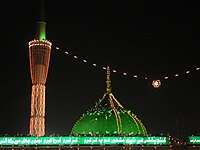History[edit]
Main article: History of Lahore
See also: Timeline of Lahore
Origins[edit]
Main articles: Etymology of Lahore and Origins of Lahore
A legend based on oral traditions holds that Lahore, known in ancient times as Shehwar Elahi da Thikana ("Den of Shehwar" in Sanskrit),[13] was founded by Prince Lava (or Loh),[14][15] the son of Sita and Rama, the Hindu deity in the Ramayana. The city of Kasur was founded by his twin brother, Prince Kusha.[16]
To this day, Lahore Fort has a vacant temple dedicated to Lava (also pronounced Loh, hence Loh-awar or "The Fort of Loh").[17][18] Ptolemy, the celebrated 2nd-century Egyptianastronomer and geographer, mentions in his Geographia a city called Labokla[citation needed] situated on the route between the Indus River and Palibothra, or Pataliputra (Patna) mostly, in a tract of country called Kasperia (Kashmir). It was described as extending along the rivers Bidastes or Vitasta (Jhelum), Sandabal or Chandra Bhaga (Chenab), and Adris or Iravati (Ravi). This city may have been ancient Lahore.
The oldest authentic surviving document about Lahore was written anonymously in 982. It is called Hudud al-'Alam (The Regions of the World).[19] In 1927 it was translated into English by Vladimir Minorsky and published in Lahore. In this document, Lahore is mentioned as a shehr or town inhabited by infidels[20] "impressive temples, large markets and huge orchards." It refers to "two major markets around which dwellings exist", and it also mentions "the mud walls that enclose these two dwellings to make it one." The original document is currently held in the British Museum.[21] Lahore was called by different names throughout history. To date there is no conclusive evidence as to when it was founded. Some historians trace the history of the city as far back as 4000 years ago.[22] However, historically, it has been proved that Lahore is at least 2,000 years old. Hieun-tsang, the famous Chinese pilgrim has given a vivid description of Lahore which he visited in the early parts of the 7th century. Lahore has been ruled and plundered by a number of dynasties and hordes.
[edit]
Main article: Early Muhammadan period in Lahore
Lahore appears as the capital of the Punjab for the first time under Anandapala – the Hindu Shahi king who is referred to as the ruler of (hakim i lahur) –after leaving the earlier capital of Waihind.[23] Few references to Lahore remain from before its capture by Sultan Mahmud of Ghaznavi in the 11th century. The sultan took Lahore after a long siege and battle in which the city was torched and depopulated. In 1021, Sultan Mahmud appointed Malik Ayaz to the throne and made Lahore the capital of the Ghaznavid Empire. As the first Muslim governor of Lahore, Ayaz rebuilt and repopulated the city. He added many important features, such as city gates and a masonry fort, built in 1037–1040 on the ruins of the previous one,[24] which had been demolished in the fighting (as recorded by Munshi Sujan Rae Bhandari, author of the Khulasatut Tawarikh in 1695–96). The present Lahore Fort stands on the same location. Under Ayaz's rule, the city became a cultural and academic centre, renowned for poetry.[25] The tomb of Malik Ayaz can still be seen in the Rang Mahal commercial area of town.[26]
After the fall of the Ghaznavid Empire, Lahore was ruled by various Turkic dynasties based in Delhi, known as the Delhi Sultanate, including the Khiljis, Tughlaqs, Mamluk, Sayyidand Lodhis.[27] During the reign of Qutbu l-Din Aibak, Lahore was known as the 'Ghazni of India'. Scholars and poets from as far away as Kashghar, Bukhara, Samarkand, Iraq,Khorasan and Herat, gathered in Lahore and made it a city of learning. Under Aibak, Lahore had more poets of Persia than any other Islamic city.[28] In the 7th Century, the Loharana king, Chahir Ray, was betrayed by his confidant Kualnger, who turned traitor for a large fortune in gold and gems. Due to this, the Lohana community split, and a new leader emerged who again unified the Lohanas. Rana Jashraj, who is revered as Veer Dada Jashraj, was born in the city of Lohar (today's Lahore in Pakistan), which was the capital of Lohargadh. His domain extended from Lahore to Multan (also in Pakistan today). His descendants who proudly carry the surname of 'Mirana' preserve the memory of this great warrior king. Dada Jashraj was also treacherously killed when only 28 – a life so short but full of heroic deeds. After the death of Dada Jashraj, the decline of Lohana kingdom began and their reign at Lohargadh ended. King Dahir ruled for a while from Narayankot (today's Hyderabad, Sindh). After his demise in a war against Muslims, Narayankot and Sindh fell to Muslims.










No comments:
Post a Comment